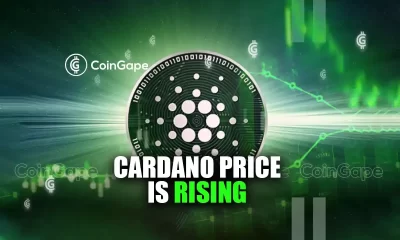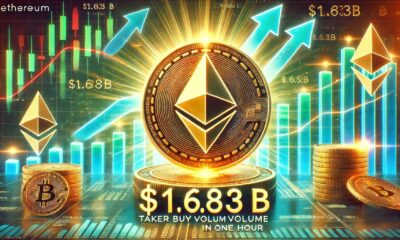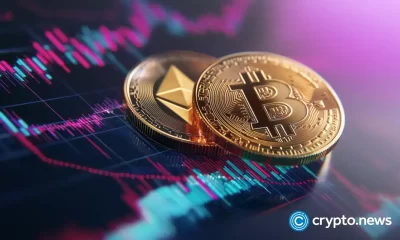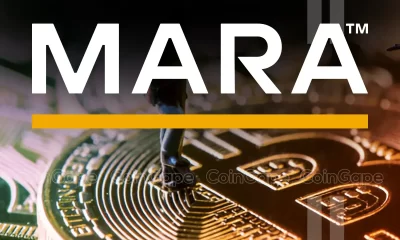Learn
How many Shiba Inu coins are there? Current supply & future outlook
Published
2 months agoon
By
admin
Shiba Inu (SHIB) coin is a major contender for the meme coin throne, often referred to as as the ‘Dogecoin killer’ by its supporters.
As the coin continues to grow, more people are interested in the tokenomics of this project and find themselves wondering how many Shiba Inu coins are in circulation.
Understanding Shiba Inu coin (SHIB)
Shiba Inu was created in August 2020 by pseudonymous developers. Unlike tokens that live on a dedicated network, (SHIB) is an ER-C20 token that exists on the Ethereum blockchain. As such, it has access to DeFi and related services, giving it an advantage over similar meme coins with less utility.
This utility, coupled with an unusually high token supply, which we’ll discuss in the next section, has proven to be a distinguishing factor that has helped Shiba Inu stand out.
The ecosystem now includes projects like ShibaSwap (a decentralized exchange), NFTs, and the play-to-earn game Shiba Eternity.
With a dedicated community, the coin has exploded in popularity, becoming one of the top 20 cryptocurrencies by market cap now today.
Total supply of Shiba Inu coins
The Shiba Inu supply upon its 2020 launch was 1 quadrillion SHIB tokens, or one thousand trillion tokens. When SHIB was released, it had the largest token supply in the world. Unsurprisingly, the massive Shiba Inu circulating supply made news headlines and helped the project gain attention worldwide.

It’s worth noting that a large supply doesn’t necessarily impact the value or use case for the project, and many in the space viewed the supply as a gimmick. For new crypto users unfamiliar with tokenomics, it may have also seemed that SHIB tokens were ‘cheaper’ than other crypto tokens, and therefore more affordable.
Of course, the price of an individual crypto token shouldn’t be conflated with the worth of the actual crypto project itself! We’ll dig into how to understand the supply of a cryptocurrency in more detail later on, but first, let’s take a look at how many Shiba Inu coins are available today.
Current circulating supply of Shiba Inu
The SHIB crypto has not maintained its supply, and it currently stands at 589 trillion SHIB. Ethereum co-founder Vitalik Buterin sent 410 trillion tokens to a dead wallet in 2021, effectively destroying or ‘burning’ the tokens and stating he would donate the remainder to charity.
The SHIB community as a whole has also burned or destroyed large portions of the initial supply in order to make SHIB deflationary, meaning it becomes scarcer over time. In true crypto fashion, the community decides when these burns will take place democratically, with those who own the most SHIB tokens having the most voting power.
While it’s likely that the dev team are major shareholders, their identity is unknown and it’s not clear who the main voters in the community are.
This is aimed at reducing the total amount of Shiba Inu coins in an effort to make the tokens scarcer and thus, ideally, worth more money. Again, this comes down to the percentage of the supply owned per investor. If an investor owns 10 tokens in a project with a supply of 100 tokens, they own 10% of the total supply.
If the community burns 50 tokens and leaves just 50 in the total supply, that same investor now owns 20% of the total supply instead of 10%, and this may translate into a value increase for that investor.
Of the 589 trillion tokens left in the supply, a portion remains in locked or burned wallets, and this adds further scarcity to the token supply.
Why supply matters to investors
The value of a cryptocurrency is the number of coins multiplied by the price of the coins.
Market cap = price x supply.
This is true for regular companies and their stocks as well.
For example, Apple Inc. stock is worth $170 per share, while Berkshire Hathaway stock is worth $685,000 per share.
So is Warren Buffet’s Berkshire Hathaway company worth more than Apple Inc.?
No.
Apple is worth three and a half times more than Berkshire Hathaway, with a market cap of $3.45 trillion vs. $984 billion.
That’s because Apple has more shares than Berkshire Hathaway. The number of shares really doesn’t impact the price or value of the company at all, it’s simply a fairly arbitrary way of dividing up shares for sale.
Similarly, when someone buys SHIB tokens, they are buying a percentage of the overall supply.
So a project could have an even lower token price than SHIB, but be worth more due to having a higher market cap.
Investors are not concerned with how many units of a stock or a cryptocurrency they have, but what value those units represent.
In short, investors need to look at the token price and total supply when calculating the market cap, and the market cap is the actual value of the project, not the token price.
Future of Shiba Inu supply
The future of the SHIB supply will play a major role in the price of the project.
While burns are not typically announced ahead of time, they happen regularly and can be tracked online through tools like the Shibburn account on x.com
HOURLY SHIB UPDATE$SHIB Price: $0.00001623 (1hr 1.50% ▲ | 24hr -2.06% ▼ )
Market Cap: $9,517,223,488 (-2.64% ▼)
Total Supply: 589,269,152,127,483TOKENS BURNT
Past 24Hrs: 2,633,223 (226.54% ▲)
Past 7 Days: 2,006,818,487 (6121.99% ▲)— Shibburn (@shibburn) October 3, 2024
It’s not clear how many SHIB tokens will be burned in the future, and the project team will likely use the burning mechanism in response to headwinds against price as they see fit. Other price factors to be monitored include community initiatives and staking activities as well as any strategic partnerships secured by Shiba Inu.
Comparing Shiba Inu’s supply to other cryptocurrencies
As we now know, the Shiba Inu supply is unusually high.
We also know that this supply alone does not dictate the worth of a cryptocurrency, but needs to be factored in alongside token price and market capitalization.
Shiba Inu vs. Dogecoin (DOGE): Dogecoin has a circulating supply of approximately 141 billion DOGE. Unlike SHIB, which has an active burn mechanism, Dogecoin has an unlimited supply with annual inflation.
Shiba Inu vs. Bitcoin (BTC): Bitcoin is known for its capped supply of 21 million BTC, with over 19 million BTC already in circulation. Bitcoin also has a halving mechanism whereby the number of bitcoins minted each year is reduced by half every four years, making Bitcoin an increasingly scarce and deflationary asset. Unlike SHIB, the Bitcoin halving is programmatic and pre-ordained.
Bitcoin will halve its supply every four years and stop minting new tokens altogether in the year 2140. The certainty of this deflationary mechanism is one of the aspects of the Bitcoin project that has made it so valuable.
FAQs
How many Shiba Inu coins were initially released?
Initially, 1 quadrillion Shiba Inu coins were released when SHIB was launched in August 2020.
How many Shiba Inu coins are left?
After Vitalik Buterin’s burn and ongoing community-led burns, the total circulating supply of Shiba Inu is around 589 trillion SHIB.
How many Shiba Inu coins are burned daily?
The number of SHIB tokens burned daily varies, as it is often community-driven. At the time of writing, over two billion tokens were burned in the past week.
How many Shiba Inu coins are mined per day?
Unlike Bitcoin, Shiba Inu cannot be mined. The entire supply was minted and released upon launch, and no new tokens will be created.
Who owns the most Shiba Inu?
Currently, the largest holders of Shiba Inu include decentralized exchanges (DEXs) and wallets linked to community initiatives. Vitalik Buterin remains a major holder, and the other holders are unknown.
Source link
You may like


Cardano Price Hits $1 But Analyst Says This Is Just The Start


Legacy Media’s Transformation: Why Evolution Beats Extinction


Massive Ethereum Buying Spree – Taker Buy Volume hits $1.683B In One Hour


Ethereum lags behind Bitcoin but is expected to reach $14K, boosting RCOF to new high


Bitcoin Miner MARA Buys Another 5771 BTC As Price Nears $100k


Jason "Spaceboi" Lowery's Bitcoin "Thesis" Is Incoherent Gibberish
crypto education
What is a crypto swap? Crypto swaps explained simply
Published
2 weeks agoon
November 8, 2024By
admin

A token swap, or crypto swap, is like trading your favorite Pokemon cards with anyone you like online. But instead of trading cards, you can trade digital crypto assets in exchange for your favorite crypto tokens, often, without a conventional centralized crypto exchange.
In this article, we take a deep dive into crypto token swaps, common types of swaps, how they work, and how you can perform a crypto swap easily.
What is a crypto swap?
What is a crypto swap?
A crypto swap is an exchange of cryptocurrencies usually performed on dedicated swap platforms, or decentralized exchanges (DEX).
Instead of going the traditional way of selling a fiat currency for a crypto token, you can directly swap crypto tokens. This is helpful especially if you want to avoid KYC restrictions and don’t want to pay additional fees associated with centralized crypto exchanges.
Swapping tokens in crypto can be done on the same blockchain or across different blockchains, a feature offered by almost every decentralized crypto swap platform. Swapping cryptocurrencies is an ideal way to rebalance your crypto holdings, or step foot into the exciting world of decentralized finance (DeFi) where lending and borrowing can be a game changer for many users.
Types of Token Swaps
Token swaps can have many types, but the most common and important categories include on-chain and off-chain swaps.
Centralized exchanges usually carry out off-chain swaps, facilitating the transaction inside their own database as opposed to on a public ledger. Although this kind of token swap is quicker and might have cheaper costs, it presupposes confidence in a centralized exchange.
On the other hand, on-chain swaps take place solely on the blockchain and manage user-to-user transactions via smart contracts. These on-chain swaps are very common on DEX platforms like Uniswap and PancakeSwap, where buyers and sellers conduct on-chain transactions with each other via decentralized processes.
Both types of cryptocurrency swaps have special benefits: off-chain swaps give efficiency and speed, while on-chain swaps offer transparency and decentralization. You can choose any type of token swap based on your comfort level with speed, security, and control over your assets.
Common use cases
For several reasons, token swaps are becoming more and more common, particularly in the DeFi community. Portfolio diversification is one of the main use cases; investors can simply exchange crypto tokens to distribute their funds among several projects without leaving the cryptocurrency market. Yield farming, in which users exchange tokens needed to engage in yield-generating activities on DeFi platforms, is another popular application.
Since some projects only work with particular crypto tokens, swapping tokens in cryptocurrency is also useful for accessing decentralized applications (dApps) and making NFT purchases. For example, a token swap allows you to join a gaming platform that requires a specific cryptocurrency asset with little difficulty. As a result, token swaps are now an essential component of the crypto toolbox, facilitating user interaction with a variety of applications.
How do crypto swaps work?
There are some key fundamental ways in which cryptocurrency swaps work, and they frequently differ depending on whether they are off-chain or on-chain.
Smart contracts play a key role in on-chain swaps. The smart contract returns the swapped token to the user after locking the original token in escrow when a user initiates a swap. Because these transactions are decentralized and trustless, users maintain complete control over their money throughout the transaction, negating the need for an intermediary.
Cryptocurrency traders provide liquidity to liquidity pools provided by decentralized exchanges (DEXs). This allows other users to swap their favorite tokens and essentially creates an organic marketplace of buyers and sellers, which eliminates the need of traditional order books.
On the other hand, off-chain swaps are purely conducted on centralized exchanges, hence their data is not recorded on any public blockchain. This method allows users to benefit from lower fees and faster transaction processing times.
Both on-chain and off-chain swaps have different benefits when it comes to transparency, speed, and cost, which allows users the liberty to choose the method that suits their needs. With crypto swaps explained, let’s move on to why they’re important.
Why are token swaps important in crypto?
The crypto ecosystem can only thrive if its accessibility and functionality become at par with the understanding of crypto users. This is where token swaps come into the picture, as they fulfill both these parameters.
Token swaps give users the liberty to adapt to volatile crypto market conditions as they can easily get new tokens by participating in DeFi activities including staking, lending, and yield farming. In addition, users can also diversify their portfolios and swap tokens through liquidity pools. All of this opens up a new pathway for new crypto users to get familiar with the world of web3.
The benefits of token swaps aren’t just limited to the crypto user. Blockchains also benefit from token swaps, as their interoperability is enhanced, thanks to cross-chain swaps, that facilitate the exchange of assets between blockchains.
This entire procedure attracts new investment and promotes innovation across blockchain projects that start to provide a more diverse amount of tokens and DeFi platforms to the end users.
Crypto token swap vs token migration
A token swap is defined as exchanging one cryptocurrency for another, which can be on the same blockchain or across different blockchains. The process of token swapping allows users to diversify their crypto asset holdings and reposition themselves in the volatile cryptocurrency markets.
On the other hand, token migration is the process of a cryptocurrency project moving from one blockchain to another. For example, a layer-1 protocol can decide to move to a layer-2 blockchain to get additional benefits of lower transaction costs and increased speeds.
When token migration happens, usually a cryptocurrency project issues a new token with a new ticker, and all users have the option to seamlessly transition their current holdings to the new one. A recent example of this is $MATIC which was migrated to $POL, and the spot holdings of $MATIC tokens held by users were converted into $POL automatically.
Risks and considerations
Token swaps do offer a certain level of comfort to users, however, they are associated with some risks as well. For example, while doing on-chain swaps cryptocurrency traders can experience issues like slippage, where a swap doesn’t get executed at the intended price levels, which can lead to potential losses.
Another risk is that users have to evaluate the security of the platform on which they are conducting these token swaps. This is because if smart contracts running behind a token-swapping platform are compromised, all funds can be lost.
In off-chain token swaps, users can face the risk of counterparty default, which means that the centralized exchange sometimes fails to execute the transaction properly. While the fees and speed of a transaction might be lower on off-chain token swaps, users still have to analyze the security aspect of the centralized exchange.
In token migrations, users can face issues related to wallet compatibility, lack of support during the transition process, and the crypto exchange not supporting the token migration to begin with. All of these risks can lead to potential losses, and to avoid this, users can make sure that the cryptocurrency project’s team is reliable and has announced a partnership with the exchange before doing the token migration.
How to perform a token swap: step-by-step guide?
A token swap is a simple process, here are some steps you can follow to complete a token swap.
Connect your wallet: Connect or create a digital crypto wallet from scratch, for example, Metamask. Make sure you have the crypto token you want to swap in it.
Choose your swap tokens: Go on any decentralized exchange, for example, Uniswap, and select both tokens, i.e. the token you want to swap and the token you want to get in return.
Enter the amount: Enter the amount of tokens you want to swap.
Double-check the amount and fees: Check the fees displayed on Uniswap that will occur for the entire swap process.
Accept the transaction: Accept the transaction in your digital crypto wallet.
Wait for confirmation: Wait for a few seconds to minutes for the transaction to complete and for the tokens to show in your digital crypto wallet. You have now swapped a token in the cryptocurrency market!
Where to swap crypto?
Crypto swaps can be done on centralized exchanges like Binance, OKX, Coinbase, etc. You can also select a decentralized exchange like PancakeSwap or Uniswap. Both of these options have their own advantages, for example, centralized exchanges offer a user-friendly interface with customer support.
Meanwhile, a DEX platform provides control over your assets and privacy, as there is no requirement to do KYC unlike on the centralized platforms.
Are crypto swaps taxable?
In most countries, crypto swaps can be a taxable transaction. Exchanging cryptocurrencies triggers capital gains or losses so it may be taxable. It is advised to consult a tax expert and also check your country’s laws before engaging in any crypto swap transaction.
Also, do research before engaging in any crypto swaps due to the high risks involved in both off-chain and on-chain swaps. To swap token in crypto, it’s important to know the ins and outs of the exchange or service you’re dealing with as well as tax implications,
Source link
crypto assets
How many cryptocurrencies are there? Total number and types
Published
2 weeks agoon
November 7, 2024By
admin
The first cryptocurrency appeared in 2009, and today, its name is known by almost everyone — Bitcoin. What made it so intriguing was the promise of a new kind of money: no government interference, full privacy, and everyone having the same rights within the system.
At first, Bitcoin (BTC) was not taken seriously. It wasn’t until 2013, when its price passed a few hundred dollars, that the rise of cryptos really took off, and they began spreading and multiplying globally. So, how many cryptocurrencies are there today?
How many cryptocurrencies are in the world?
Statista reports that by September 2024, the number of cryptocurrencies is getting close to 10,000. However, it’s worth noting that many of these cryptocurrencies may not be particularly relevant or active.
Statista also notes that other sources estimate there are around 20,000 cryptocurrencies in existence, though most of these are either inactive or have been discontinued.
As of early November CoinMarketCap, a leading cryptocurrency data aggregator that tracks prices, market cap, and trading volume, lists 9,916 cryptocurrencies, while CoinGecko, another popular crypto data platform known for its comprehensive market statistics, shows 15,142.
Figuring out exactly how many cryptos there are is tricky, since the number keeps changing, but we can say this for sure: there are way more now than there were in 2009.
Why are there so many cryptocurrencies?
Thanks to easier access to blockchain technology, even those with basic coding knowledge can launch their own cryptocurrency. Platforms like Ethereum allow developers to create tokens without needing to build their own blockchain from scratch.
This low barrier to entry has led to an explosion of new projects, each claiming to offer something unique, whether it’s faster transactions, privacy features, or use in specific industries. Some even target niche markets like gaming, art, or supply chains.
While many of these coins won’t survive long-term, the ease of creation fuels constant experimentation and innovation, driving the evolution of the entire crypto ecosystem.
How many types of cryptocurrencies are there?
How many crypto are there?
With so many different types of cryptocurrencies, each designed for a specific goal, here’s a breakdown of the main categories.
Bitcoin and Bitcoin forks
Bitcoin is the first and most famous cryptocurrency, designed as a decentralized, peer-to-peer digital currency. Bitcoin forks like Bitcoin Cash (BCH) and Bitcoin SV (BSV) are versions of Bitcoin with minor adjustments to improve speed or transaction costs.
Altcoins
Altcoins are basically any cryptocurrencies that aren’t Bitcoin, each offering something unique, whether it’s new features, different uses, or fresh technology to shake up the digital currency scene. For example, Ethereum (ETH) brings smart contracts to the table, while Solana (SOL) stands out for its fast and low-cost transactions.
Stablecoins
Designed to reduce volatility, stablecoins are pegged to real-world assets like the US dollar. Tether (USDT) is the most widely used, offering stability for traders.
Meme coins
Meme coins like Dogecoin (DOGE) and Shiba Inu (SHIB) were created as fun projects but turned into something much bigger thanks to viral social media moments. Pepe Coin, inspired by the Pepe the Frog meme, has also become popular in the meme-crypto space.
Utility tokens
These tokens are used to power specific applications. Chainlink connects smart contracts to real-world data, while Uniswap is used for governance in the Uniswap decentralized exchange. Binance Coin started as a way to pay lower fees on the Binance exchange but now has broader uses across the Binance ecosystem.
How many cryptos are actually significant?
There are thousands of cryptocurrencies out there, but only a small percentage are truly significant, in terms of widespread use, market value, and technological impact. Bitcoin remains the dominant force, widely recognized as the first and most valuable cryptocurrency.
Ethereum is another heavyweight, known for its smart contract capabilities and dApps, driving much of the DeFi and NFT boom. Other notable cryptos include Binance Coin, which powers the Binance ecosystem, and Solana, praised for its high-speed transactions.
Meme coins, like Dogecoin and Shiba Inu, have certainly gotten attention, but whether they’ll have lasting value is still a big question. The crypto world is moving fast, but not many assets have truly changed the industry. The ones that have are still the ones leading in terms of innovation and market impact.
Source link
Learn
What are smart contracts? Types, benefits & use cases explained
Published
3 weeks agoon
November 1, 2024By
admin

With the advancement of IT technologies and blockchain platforms, a new type of contract has emerged: smart contracts.
In this article, we’ll explore smart contracts and how they’re being used today.
What are smart contracts. Smart contracts explained
What is a smart contract? It is like a digital agreement that runs on its own, with all the terms and conditions written directly into the code. It operates on a blockchain network, so the contract automatically carries out and enforces itself when the set conditions are met.
There’s no need for intermediaries like lawyers or banks because the contract’s rules are transparent and unchangeable once deployed. Essentially, smart contracts in cryptocurrency streamline and secure transactions, making them faster, more efficient, and less reliant on third-party oversight.
Historical background
The concept of smart contracts dates back to the mid-1990s when computer scientist and cryptographer Nick Szabo first proposed the idea.
He envisioned a digital protocol that could automatically execute the terms of a contract when predefined conditions were met, similar to a vending machine dispensing a snack when the correct amount of money is inserted.
But it wasn’t until blockchain technology came along, especially with the launch of Ethereum in 2015, that smart contracts took off. Ethereum’s blockchain gave developers the tools to create and run code that could handle complex agreements on its own. This breakthrough led to a wave of new decentralized apps, shaking things up by automating transactions and eliminating the need for middlemen.
How do smart contracts work
Smart contracts use straightforward “if/when…then…” commands written into the blockchain. They automatically handle tasks like releasing funds, registering assets, or sending notifications once conditions are met. The blockchain’s permanence ensures transactions are visible only to authorized parties.
Smart contracts can get pretty complex, involving various conditions everyone has to agree on. This means deciding on how transactions are recorded, handling any exceptions, and figuring out how to resolve disputes.
Every node in the network keeps a copy of all the smart contracts along with the blockchain and transaction data. When a contract receives funds, all nodes execute the contract’s code to agree on the result, ensuring that everything runs smoothly without a central authority.
Not every blockchain can run automated contracts, so it’s good to know which ones do and which don’t. While platforms like Ethereum, Arbitrum, Avalanche, Base, and BNB Chain do, others, like the base blockchain of Bitcoin, don’t. The main difference is whether a blockchain can handle and store complex logic. Once a smart contract is set up, it usually stays as is, even for those who created it. This stability helps it resist censorship and prevents it from being easily shut down.
Types of smart contracts
Smart contracts in blockchain generally fall into three types:
Smart Legal Contracts
Smart Legal contracts are designed to align with formal legal agreements, meaning the parties involved are legally accountable for meeting the contract’s terms. These can range from contracts that facilitate cryptocurrency-to-fiat conversions to those that handle real estate registrations.
Many existing smart contracts are legal in nature, underpinning various platforms including cryptocurrency exchanges, DeFi projects, GameFi projects, and blockchain-based platforms like NFT marketplaces and real estate tokenization platforms.
Decentralized Autonomous Organizations
DAOs are communities governed by a set of rules encoded into smart contracts. Once these rules are established, DAOs use these contracts to enforce them, provide legal mechanisms for protection, and impose penalties for breaches. Essentially, DAO smart contracts function as the organization’s laws and “digital” bureaucracy.
Examples include governance protocols for Decentraland, Uniswap, Polkadot, and MakerDAO. In these projects, governance is managed by holders of the native tokens, who can propose changes (like adjusting fee structures, altering blockchain code, or adding/removing parachains) and vote on them. DAO contracts handle the voting process and count the votes.
Application Logic Contracts
ALCs operate under a governing program and are primarily tasked with managing interactions between this program and the blockchain. For instance, ALCs might facilitate the integration of Internet of Things devices with blockchain.
Benefits of smart contracts
The advantages of using blockchain are impressive for individuals, businesses, and governments.
Transparency: One of the biggest perks is transparency. Every transaction on a blockchain is public and can be verified, so once data is added, it can’t be changed. This means you can trust that smart contracts are secure and haven’t been tampered with, giving you peace of mind whether using them personally or for business.
Cost efficiency: Smart contracts take care of a lot of the legwork when it comes to setting up and managing agreements. Since they don’t require intermediaries like lawyers, banks, or brokers, they save money and streamline processes.
Building trust: Because smart contracts are automated, they reduce the chance of human error and build trust between parties.
Secure storage and backup: Losing data is a big risk for any organization. While backups are important, they’re not always foolproof. Blockchain technology, however, keeps data across many nodes, so it’s much less likely to be lost or tampered with as long as the blockchain itself is running.
Security: Smart contracts are incredibly secure, thanks to advanced encryption and security protocols. They’re some of the safest tools for handling transactions today, offering strong protection against hacking and tampering — just like cryptos.
Use cases
Token smart contracts in cryptocurrency are used to create, manage, and assign ownership of specific digital tokens on blockchain networks. These contracts program the functionalities of the tokens they issue, giving them various roles.
For instance, they might enable tokens to serve as utility tokens for apps (offering features or benefits within an application), governance tokens that give holders voting power in a protocol, security tokens representing shares in a company, or NFTs that represent ownership of unique physical or digital assets.
Smart contracts examples
Examples of smart contracts in action:
Ethereum. Ethereum allows developers to build dapps and underpins many DeFi projects. Smart contracts on Ethereum are super flexible, handling everything from turning real-world assets into digital tokens to automating transactions. It’s a hub for a lot of groundbreaking blockchain activity.
Then there’s Binance Smart Chain. It’s celebrated for its speed and efficiency. While it’s compatible with Ethereum, it offers lower fees and better performance, making it a great choice for various projects. It’s become a popular choice for DeFi projects and tokenization due to these advantages.
Polkadot. Polkadot is all about connecting different blockchains. It lets you create parallel blockchains that can interact with each other and supports smart contracts for various applications, enhancing blockchain interoperability.
Chainlink. Chainlink is like a bridge that connects smart contracts to the real world by providing them with external data. Thanks to its decentralized oracles, these contracts can access real-time information, which makes them even more dynamic and adaptable.
Future of smart contracts
The future of smart contracts is bright and full of potential. As technology keeps evolving, these contracts are set to get smarter, safer, and more efficient. This is thanks to ongoing upgrades in blockchain tech and better programming tools.
We’re likely to see this technology contracts revolutionize industries beyond finance and legal sectors, influencing areas like supply chain management and government operations. All in all, smart contracts are gearing up to be a major force in shaping the future of our digital world.
Source link

Cardano Price Hits $1 But Analyst Says This Is Just The Start

Legacy Media’s Transformation: Why Evolution Beats Extinction

Massive Ethereum Buying Spree – Taker Buy Volume hits $1.683B In One Hour

Ethereum lags behind Bitcoin but is expected to reach $14K, boosting RCOF to new high

Bitcoin Miner MARA Buys Another 5771 BTC As Price Nears $100k

Jason "Spaceboi" Lowery's Bitcoin "Thesis" Is Incoherent Gibberish

Bankrupt Crypto Exchange FTX Set To Begin Paying Creditors and Customers in Early 2025, Says CEO

Top crypto traders’ picks for explosive growth by 2025

3 Tokens Ready to 100x After XRP ETF Gets Approval

Gary Gensler’s Departure Is No Triumph For Bitcoin

Magic Eden Token Airdrop Date Set as Pre-Market Value Hits $562 Million

Blockchain Association urges Trump to prioritize crypto during first 100 days

Pi Network Coin Price Surges As Key Deadline Nears

How Viable Are BitVM Based Pegs?

UK Government to Draft a Regulatory Framework for Crypto, Stablecoins, Staking in Early 2025
182267361726451435

Top Crypto News Headlines of The Week

Why Did Trump Change His Mind on Bitcoin?

New U.S. president must bring clarity to crypto regulation, analyst says

Ethereum, Solana touch key levels as Bitcoin spikes

Will XRP Price Defend $0.5 Support If SEC Decides to Appeal?

Bitcoin Open-Source Development Takes The Stage In Nashville

Bitcoin 20% Surge In 3 Weeks Teases Record-Breaking Potential

Ethereum Crash A Buying Opportunity? This Whale Thinks So

Shiba Inu Price Slips 4% as 3500% Burn Rate Surge Fails to Halt Correction

‘Hamster Kombat’ Airdrop Delayed as Pre-Market Trading for Telegram Game Expands

Washington financial watchdog warns of scam involving fake crypto ‘professors’

Citigroup Executive Steps Down To Explore Crypto
Mostbet Güvenilir Mi – Casino Bonus 2024

Bitcoin flashes indicator that often precedes higher prices: CryptoQuant
Trending

 2 months ago
2 months ago182267361726451435

 24/7 Cryptocurrency News3 months ago
24/7 Cryptocurrency News3 months agoTop Crypto News Headlines of The Week

 Donald Trump4 months ago
Donald Trump4 months agoWhy Did Trump Change His Mind on Bitcoin?

 News3 months ago
News3 months agoNew U.S. president must bring clarity to crypto regulation, analyst says

 Bitcoin4 months ago
Bitcoin4 months agoEthereum, Solana touch key levels as Bitcoin spikes

 Price analysis3 months ago
Price analysis3 months agoWill XRP Price Defend $0.5 Support If SEC Decides to Appeal?

 Opinion4 months ago
Opinion4 months agoBitcoin Open-Source Development Takes The Stage In Nashville

 Bitcoin4 months ago
Bitcoin4 months agoBitcoin 20% Surge In 3 Weeks Teases Record-Breaking Potential


